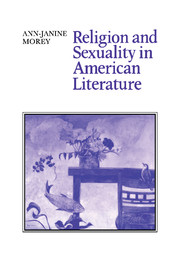Book contents
- Frontmatter
- Contents
- Acknowledgments
- Introduction
- 1 Body Language: Religion, Sexuality, and the Bioluminescence of Metaphor
- 2 The Stubborn Density of Desire: Religion and Sexuality in Nineteenth-Century Fiction
- 3 A Tradition of Divine Lechery: Men Write about the Ministry
- 4 A War of Words: Women Write about the Ministry. The Homiletic writers
- 5 Comfort to the Enemy: Women Write about the Ministry. The Parsonage Romance
- 6 The Fox in the Well: Metaphors of Embodiment in the Androcentric Imagination
- 7 Fatal Abstractions: Metaphors of Embodiment in the Gynocentric Imagination
- 8 Conclusion: Words Are Not the Thing Itself
- Appendix A The Homiletic Novels and Their Authors
- Appendix B The Parsonage Romances and Their Authors
- Bibliography
- Index
- Cambridge Studies in American Literature and Culture
2 - The Stubborn Density of Desire: Religion and Sexuality in Nineteenth-Century Fiction
Published online by Cambridge University Press: 25 March 2010
- Frontmatter
- Contents
- Acknowledgments
- Introduction
- 1 Body Language: Religion, Sexuality, and the Bioluminescence of Metaphor
- 2 The Stubborn Density of Desire: Religion and Sexuality in Nineteenth-Century Fiction
- 3 A Tradition of Divine Lechery: Men Write about the Ministry
- 4 A War of Words: Women Write about the Ministry. The Homiletic writers
- 5 Comfort to the Enemy: Women Write about the Ministry. The Parsonage Romance
- 6 The Fox in the Well: Metaphors of Embodiment in the Androcentric Imagination
- 7 Fatal Abstractions: Metaphors of Embodiment in the Gynocentric Imagination
- 8 Conclusion: Words Are Not the Thing Itself
- Appendix A The Homiletic Novels and Their Authors
- Appendix B The Parsonage Romances and Their Authors
- Bibliography
- Index
- Cambridge Studies in American Literature and Culture
Summary
For some critics, explicitly rendered sexuality is one unhappy, harrowing novelty of modern literary life. Francis Kunkel, for example, argues that too many contemporary writers “turn religious activity into sex,” a “profane” transformation indicative of the “neurotic confusion” of the writer. Kunkel's protest assumes a comparison with some unspecified period of purity. He also assumes that any sympathetic treatment of religious and sexual energy is indulged in only by the “adolescent,” “lifedefeating,” and “anti-intellectual” writer. His interpretation will bear little scrutiny when we read nineteenth- and twentieth-century texts with a less prejudiced literary eye, however.
It is true that we usually do not think of nineteenth-century literature in terms of sexual content, and certainly not in terms of explicitly rendered sexual encounter in which religion is implicated. That does not mean the religiosexual content is not there, however. The sexual frankness of modern fiction did not suddenly create a “confusion” between religion and sexuality. The convergence has always been with us. Furthermore, an experiment in metaphoric process – putting unlike passages side by side as a mutually interpretive dialectical unit – reveals a shared density about religiosexual relations that decodes no more easily in its sexually explicit twentieth-century form than in the reticences of nineteenth-century literary form.
The first passage under consideration comes from The Damnation of Theron Ware (1896) by Harold Frederic. In this novel, a naive but ambitious young Methodist minister, Theron Ware, becomes increasingly disenchanted with the bludgeon-like simplicity of his Protestant circle. His disenchantment is hastened toward rebellion by his infatuation with the fiery-haired organist at the Catholic church, Celia Madden.
- Type
- Chapter
- Information
- Religion and Sexuality in American Literature , pp. 43 - 74Publisher: Cambridge University PressPrint publication year: 1992

